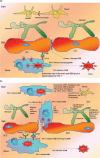Editorial neuroAIDS review
- PMID: 21076277
- PMCID: PMC4464840
- DOI: 10.1097/QAD.0b013e328340fd42
Editorial neuroAIDS review
Figures



References
-
- Minagar A, Shapshak P. HIV associated dementia: clinical features and pathogenesis. In: Minagar A, Shapshak P, editors. NEURO-AIDS. Nova Science Publ; Hauppauge, New York: 2006.
-
- Fernandez F, Ruiz P, editors. Psychiatric aspects of HIV/AIDS. Lippincott Williams and Wilkins; Philadelphia, PA: 2006.
-
- Goodkin K. Virology, Immunology, Transmission, and disease stage. In: Fernandez F, Ruiz P, editors. Psychiatric aspects of HIV/AIDS. Lippincott Williams and Wilkins; Philadelphia, PA: 2006. pp. 11–22.
-
- Goodkin K, Verma A, Shapshak P, editors. The spectrum of NeuroAIDS disorders: pathophysiology, diagnosis, and treatment. ASM Press; Washington, DC: 2008.
Publication types
MeSH terms
Grants and funding
- R03 DA026099/DA/NIDA NIH HHS/United States
- U24 MH100929/MH/NIMH NIH HHS/United States
- U01 MH083500/MH/NIMH NIH HHS/United States
- AI07126/AI/NIAID NIH HHS/United States
- CA16042/CA/NCI NIH HHS/United States
- R24 NS038841/NS/NINDS NIH HHS/United States
- P30 CA016042/CA/NCI NIH HHS/United States
- N01 MH032002/MH/NIMH NIH HHS/United States
- DA026099/DA/NIDA NIH HHS/United States
- DA07683/DA/NIDA NIH HHS/United States
- DA10442/DA/NIDA NIH HHS/United States
- MH083500/MH/NIMH NIH HHS/United States
- NS038841/NS/NINDS NIH HHS/United States
- T32 AI007126/AI/NIAID NIH HHS/United States
LinkOut - more resources
Full Text Sources
Medical

